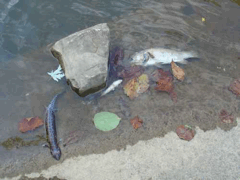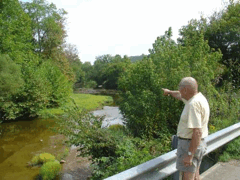Perfect Storm for Fish Kill
Air Date: Week of October 30, 2009

Dead fish and a salamander float close to shore in Dunkard Creek, days after a massive fish kill destroyed the ecosystem. (Photo: Ben Adduchio/West Virginia Public Broadcasting)
A massive fish kill at the 38 mile long Dunkard Creek on the West Virginia – Pennsylvania border has scientists and regulators wondering what went wrong. All signs point to the toxic golden algae but some say it was the polluted creek, with high levels of chloride, which provided ripe conditions for the fish kill. It’s the first time golden algae has appeared in the northern part of the country and, as West Virginia Public Broadcasting’s Erica Peterson reports, there are fears the invasive will spread to other watersheds.
Transcript
YOUNG: Dunkard Creek. Along the Pennsylvania/West Virginia border once drew crowds of fisherman and boaters until September, when almost all the aquatic creatures living in the creek died. Regulators blame the fish kill on a bloom of toxic golden algae fueled by pollution from nearby coalmines and gas drilling sites. This is the first time they’ve documented the invasive golden algae in the region. And, as Erica Peterson of West Virginia Public Broadcasting reports, the same pollution that fed the bloom in Dunkard Creek could help the algae spread across the Mid-Atlantic.
[WATER RUNNING]
PETERSON: Until recently, Dunkard Creek was teeming with life – with more than 160 species of fish, mussels, salamanders and crayfish. But in September, a massive fish kill eliminated nearly every living thing in this creek, which winds 38 miles back and forth across the Mason-Dixon Line.
[INSECT SOUNDS; MOVING WATER; GRAHAM SAYING “FRESH WATER’S COMING IN…]
PETERSON: Jesse Graham walks along the banks of Dunkard Creek the morning after the fish kill in mid-September. Dead fish line the banks. Buzzards circle overhead.
GRAHAM: Have you ever been around the ocean where they’re doing crabs and so on and they’re old and decaying? That’s what it smells like.
PETERSON: Graham has lived on the banks of Dunkard Creek since 1970, and says it’s always seemed to be a healthy stream, until now.
GRAHAM: I had a deer come up the driveway, I think looking for water, because I’ve never had a deer come up the driveway like that. They probably were used to drinking in the Dunkard and they knew it wasn’t fit to drink and they were looking.
PETERSON: Now, Dunkard Creek is a rusty color and regulators in West Virginia say golden algae killed the ecosystem. Golden algae have been found in Southern and Southwestern states, and are typically found in freshwater areas with a high salt content. Officials don’t know how the invasive algae got into Dunkard Creek, but believe it flourished because of massive amounts of salty pollution from coalmines and gas drilling. Randy Huffman is the head of the West Virginia Department of Environmental Protection. He says a lot of different factors contributed to the toxic bloom.
HUFFMAN: The algae is the culprit, but the water temperature, the sunlight, and the makeup of the water from the mine drainages, we think, have worked together to create the perfect storm for this algae.

Jesse Graham points to the spot on Dunkard Creek where he first noticed dead fish. Graham has lived near Dunkard Creek since 1970 and never knew the creek was so polluted. (Photo: Ben Adduchio/West Virginia Public Broadcasting.)
PETERSON: This “perfect storm” was partly made possible by negligence—on the part of Huffman’s agency, as well as others. The pollution can be traced back to mining company Consol Energy. Consol is the nation’s fifth largest coal producer, and contributes more than 500 million dollars a year to West Virginia’s economy. It operates in five other states. For years, Consol has been releasing chloride and other pollutants into Dunkard Creek from two separate mines. And the West Virginia Department of Environmental Protection let them. Starting in 2002, the DEP issued three orders allowing Consol to violate the federal Clean Water Act as it looked for a way to control the pollution. While at a talk on business ethics, Consol spokesman Joe Cerenzia says his company’s discharge was harmless until the algae were added into the mix.
CERENZIA: For the past however many years, the fish were fine and all of the aquatic life in Dunkard Creek were surviving just fine. It’s this additional element that was put in there that has changed the dynamics of that whole situation.
PETERSON: The situation was complicated by the fact that Dunkard Creek crosses state lines, with two states and the federal Environmental Protection Agency overseeing pollution. Currently, Consol has a permit from the EPA to dispose of salty wastewater from a Pennsylvania gas drilling operation into one of the West Virginia mines that discharge into Dunkard Creek. The EPA ordered Consol to stop injections last month.
[WALKING ON DIRT PATH]
PETERSON: The residents who live along Dunkard Creek had no idea how polluted it was becoming – until it was too late.
WILEY: Dunkard Creek is a member of the family.
PETERSON: Betty Wiley is the president of the Dunkard Creek Watershed Association, a local non-profit that promotes the importance of the watershed.

Dead fish and a salamander float close to shore in Dunkard Creek, days after a massive fish kill destroyed the ecosystem.
(Photo: Ben Adduchio/West Virginia Public Broadcasting)
WILEY: It’s grief, it’s real grief, like a member of the family died, only you can’t bury this one. It’s still there, and you have to do something about it. Try to bring it back to life.
PETERSON: In a park along the Mason-Dixon Line, Wiley looks at old photographs of the creek. One shows her father smoking a pipe and holding his day’s fishing catch: seven fish. Now, Wiley worries other streams across the country could suffer the same fate.
WILEY: I think it’s national in scope. It’s a huge environmental disaster, really. When did you ever know of a 38-mile long ecosystem being just totally being wiped out? Totally, everything’s dead.
PETERSON: The factors that made Dunkard Creek an ideal golden algae habitat, like large amounts of chlorides and other pollutants, are replicated throughout the state and the region.
[MANDIROLA SAYING “NOW THAT WE KNOW ITS GOLDEN ALGAE THAT;S ACTUALLY DOING THE KILLING OF THE FISH, WE NEED TO FIGURE OUT WHY…]
PETERSON: Scott Mandirola oversees water programs with the West Virginia DEP. In a presentation about the fish kill to state legislators, he points to a list of 20 other streams and rivers ripe for algae blooms. Now that golden algae has made its way north, he says it’s possible it could invade other similar watersheds in other states, like the north branch of the Potomac River in Maryland and West Virginia.
MANDIROLA: We don’t know exactly how the algae got here, we don’t know if it’s been here for a while or if it just came in the last year or so. Our concern is, because we’re not clear on how it transports, if it does transport to another ecosystem that has a conducive environment, we could see a similar bloom.
PETERSON: Once it’s in a waterway, golden algae are nearly impossible to eliminate. In West Virginia, the DEP now wants to lower the pollution levels in these streams to make them more hospitable to green algae—which isn’t toxic, and could prevent the spread of its golden cousin. But first, state and federal regulators have to do something they haven’t so far -- put tighter pollution controls in place, and enforce them. For Living on Earth, I’m Erica Peterson in Charleston, West Virginia.
Links
Dunkard Creek Watershed Association
West Virginia DEP – info on Dunkard Creek water quality
West Virginia Public Broadcasting coverage of the Dunkard Creek fishkill
Living on Earth wants to hear from you!
Living on Earth
62 Calef Highway, Suite 212
Lee, NH 03861
Telephone: 617-287-4121
E-mail: comments@loe.org
Newsletter [Click here]
Donate to Living on Earth!
Living on Earth is an independent media program and relies entirely on contributions from listeners and institutions supporting public service. Please donate now to preserve an independent environmental voice.
NewsletterLiving on Earth offers a weekly delivery of the show's rundown to your mailbox. Sign up for our newsletter today!
 Sailors For The Sea: Be the change you want to sea.
Sailors For The Sea: Be the change you want to sea.
 The Grantham Foundation for the Protection of the Environment: Committed to protecting and improving the health of the global environment.
The Grantham Foundation for the Protection of the Environment: Committed to protecting and improving the health of the global environment.
 Contribute to Living on Earth and receive, as our gift to you, an archival print of one of Mark Seth Lender's extraordinary wildlife photographs. Follow the link to see Mark's current collection of photographs.
Contribute to Living on Earth and receive, as our gift to you, an archival print of one of Mark Seth Lender's extraordinary wildlife photographs. Follow the link to see Mark's current collection of photographs.
 Buy a signed copy of Mark Seth Lender's book Smeagull the Seagull & support Living on Earth
Buy a signed copy of Mark Seth Lender's book Smeagull the Seagull & support Living on Earth

